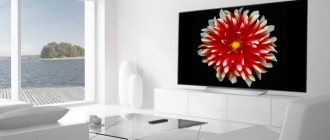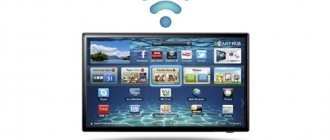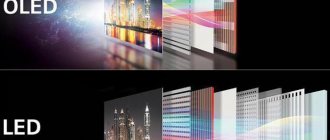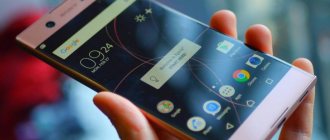The Samsung and Sony brands are known throughout the world. Their TVs are popular, but each brand has its supporters and opponents. If you compare models from both companies, you can understand that they have a lot in common, but there are also differences, which we will look into.
Both companies are direct competitors of each other, which annually release updated models and even TV lines. The wealth of choice only complicates the purchase when you need good equipment at a reasonable cost. The comparative analysis will help highlight the features of each brand and make the right choice.
Which brand is better - LG, Samsung or Sony?
If you are looking for a new TV, the market is ready to offer you a huge selection.
What is important to you - smart features, advanced screen settings, or compatibility with other devices you already have? Shopping can be overwhelming and the flow of information can be confusing. In such a situation, we suggest that you narrow your search to just one brand. We review dozens of TVs every year, from premium models to the most affordable budget models, and we can confidently say that the differences between individual brands can be huge. The brand name can tell you a lot, such as what smart features may be included, what technology is used to create the panel, and how high-quality the TV is in terms of longevity.
Among the variety of manufacturers today, three main players stand out: LG, Samsung and Sony. Considering that each TV model has its own unique set of advantages and disadvantages, which we always note in our reviews, we will try to compare these giants in this article.
Design
The Sony Xperia 10 Plus and Samsung Galaxy A50 devices have many differences in appearance. In particular, the Xperia 10 Plus is a rectangular oblong phone with a 6.5-inch screen and rectangular corners. Due to its greater height, it has a smaller width, 73 mm versus 74.7 for Samsung. At the same time, the South Korean smartphone has less weight - only 166 g versus 180 g for its competitor.
Ixperia is made using plastic and metal, while Samsung is made using plastic and glass. There are several color options to choose from. Sony has a better range. There are black, blue, gold and silver shades to choose from, while Samsung has a more limited choice - black, white and blue.
Of the mechanical buttons, Sony has power, camera launch and volume control keys, while Samsung does not have a shutter button.
Samsung: Vibrant QLED quality, great smart features
Behind:
- Best-in-Class QLED Displays with Quantum Dot Technology
- Great Smart TV platform
- High degree of integration with home network devices
- Full range of smart features, even in mid-range models
Against:
- Bixby voice assistant is inferior in quality to its competitors Amazon Alexa and Google Assistant
- Instead of Dolby Vision technology, Samsung uses its own HDR10+ technology
Our rating:
- Best Samsung TV: Samsung Q90 QLED
- Best Samsung TV under RUB 60,000: Samsung Q60 QLED
- The best Samsung TV for less than RUB 30,000: Samsung NU7100 124 cm diagonal
Samsung is the world's largest TV manufacturer.
Much of Samsung's dominance comes from its line of QLED models, which are advanced versions of LCD panels with picture quality comparable to OLED and even better in some aspects. When someone says, “I would like to buy an OLED TV, but...”, our advice is always the same: “Check out Samsung QLED TVs as a great alternative.” We installed the new Samsung Q90 QLED next to the LG OLED for comparison and could hardly find any significant differences that would indicate the shortcomings of one or another model. And this despite the fact that Samsung costs significantly less.
Quantum dot technology has enabled Samsung to achieve major improvements in the quality of traditional LED screens. As a result, QLED TVs from Samsung are distinguished by high color and brightness, have a wide viewing angle and provide a vivid picture even in strong lighting conditions.
While mid-range models don't have the benefits of quantum dot technology in the QLED lineup, Samsung's standard LCD TVs are also excellent quality with good levels of brightness, color, and decent HDR performance.
Samsung pays great attention to the aesthetics of its products, taking care of the design of not only the front, but also the back of the TV. And if the regular QLED line doesn’t appeal to you, you should pay attention to the stylish Frame and Serif models, reminiscent of works of art. Less expensive models, such as the 165cm Samsung LED NU6900, are not as flashy, but still have some charm.
However, there is one more parameter that particularly sets Samsung TVs apart - these are smart functions. The Smart TV platform, installed on a wide range of models, from premium class to budget options, offers a large selection of applications and personal settings. The easy-to-navigate interface contains a wealth of possibilities. Plus, some features you can only find on a Samsung TV.
First, there's the Apple TV app, which you don't need to have an Apple device to access. This is an exclusive offer from Samsung that gives you the opportunity to see all your iTunes movies and TV shows on the big screen, as well as watch original programming from the soon-to-be-launched Apple TV channel without having to purchase a separate set-top box.
Samsung also offers unparalleled ease of home network integration, ensuring its TVs are compatible with the entire Samsung SmartThings ecosystem and a wide range of third-party devices. From our point of view, this is the best brand for smart home enthusiasts.
While we recognize the high quality of Samsung TVs, we also note some of their shortcomings. And the biggest among them are akin to self-inflicted injuries. For example, Bixby is Samsung's proprietary voice assistant. While it's not as accurate or fast as Google Assistant or Amazon Alexa, it leaves a pretty good impression when it works. But when it doesn't work, you're frustrated and forced to repeat commands to your remote over and over again, hoping it will finally understand.
Another issue is Samsung's attempt to enter the HDR format war by promoting its own HDR10+ technology. This means that the South Korean giant's TVs do not support the Dolby Vision feature, which many consider to be the leader in quality. As a result, HDR10+ content is limited to a very small selection of Blu-ray discs and streaming video from Amazon Prime, which deprives a large army of TV viewers of the opportunity to enjoy an interesting new visual technology.
Sony smartphones: advantages
At one time, the Sony Xperia XZ Premium smartphone caused a lot of noise, and until now, according to most, this device is the best the company has ever released.
- The first thing that catches your eye is the design. Sony tried very hard to somehow diversify the look of their smartphones and created a truly beautiful back panel. A completely mirrored, high-quality cover is a rarity for smartphones. In addition, the company has not deprived the body of the new device of its signature feature – completely square corners. This made using the smartphone even more comfortable: the phone fits nicely in the hand and attracts attention with its appearance.
- The second, and very important quality, inherent in most flagships from Sony is amazing sound. Both the headset and the main speakers perform well in action. A functional multimedia center is the second feature of this device.
- The cameras in Sony devices are also impressive. We are already silent about daytime photography; nowadays even mid-price smartphones can cope with this. But at night or in poor lighting, Sony shoots many times better than its competitors, and so far not a single smartphone has been able to compete with the Sony Xperia XZ Premium.
- There's no need to talk about performance. With Snapdragon on board, phones just fly.
LG: Great OLED screens with lots of smart features
Behind:
- Excellent quality of OLED and NanoCell TV series
- The best, in our opinion, smart platform
- Many models are equipped with built-in voice assistants from Google and Amazon
- Premium models feature advanced network solutions
Against:
- The limited brightness of OLED screens can reduce the viewing experience in a well-lit room
- Brightness and HDR quality in NanoCell LCD screens are not always at a high level
Our rating:
- Best LG TV: LG C9 OLED
- The best LG TV for less than RUB 60,000: LG UM7300 4K 165 cm diagonal
- Best LG TV under RUB 30,000: LG UK6300 4K 126 cm diagonal
LG's current OLED lineup includes what we believe is the best model of 2021, the LG C9 OLED, and represents a radical new take on how a modern TV should look and function.
And the new W-Series Wallpaper TV (recently named LG W9 OLED) and Signature Series R Rollable TV (expected in 2020) have become real innovations in design and technology. The advantages of OLED models are undeniable and lie in the excellent combination of color reproduction and the highest backlight accuracy at a level superior to any LCD screen. Controlling the emission of each pixel is the highlight of OLED technology, allowing the display to reflect true blacks and highlight bright parts of HDR frames without blowing out other areas of the image.
LG demonstrates the same high competitiveness in its NanoCell mid-range line that follows OLED. NanoCell technology aims to maximize image quality by controlling the color of each of the screen's 8 million pixels. This nano-level filtering allows for deeper black tones and wider viewing angles, delivering excellent quality for a standard LCD TV.
LG is also the only manufacturer currently equipping its models with HDMI 2.1 ports. The higher bandwidth of version 2.1 allows you to view high frame rate content on your TV, enables VRR (Variable Refresh Rate) for enhanced video game playback, and eARC (Enhanced Audio Return Channel) for lossless audio output.
The LG C9 OLED TV has all four HDMI ports using the new 2.1 version, which is also present in all 2019 OLED models (W9, E9, C9) and NanoCell 4K 9500 and 9000.
LG has made a serious effort to improve the TV's smart features, updating the webOS platform (voted by us as the best TV platform of 2021) and providing access to two built-in voice assistants, Google Assistant and Amazon Alexa. WebOS in the same version as in OLED TVs is also installed on mid-range models produced using LCD technology.
LG TVs are a good choice for those who are particularly demanding about picture quality. With tech features like a built-in calibration template generator, LG models are worthy of Hollywood studios. And special expert screen modes, created with the help of Technicolor and the Imaging Science Foundation (ISF), provide ample opportunities for fine-tuning the screen.
Sony: some of the best (and most expensive) TVs on the market
Behind:
- high quality video processing, creating a clean image and high-quality conversion of low-format material
- high quality acoustics
- the presence of a smart Android TV platform, giving access to a huge collection of applications
- Chromecast and Google Assistant built-in
- special calibration mode for Netflix content
Against:
- prices are higher than competitors
- inconvenient control panel in older models
- complex settings
Our rating:
- Best Sony TV: Sony Master Series A9F OLED
- The best Sony TV under RUB 60,000: Sony XG85 4K 124 cm diagonal
- The best Sony TV under RUB 36,000: Sony XF70 4K 109 cm diagonal
And last in our line, but not the least important, is Sony.
Once the undisputed leader in the audio and video market, Sony is still a highly respected TV manufacturer. And it's no coincidence that the Sony AF9 OLED TV is, in our opinion, the most beautiful TV on the market. Even mid-range models with a standard LCD screen, such as the Sony XG95, provide rich, natural colors thanks to high-quality video processing, support for 10-bit color and HDR format. The AF9 is one of many Sony TVs that boast impeccable pictures, great sound and impressive overall quality. Using the glass panel of the OLED screen as the sound source, advanced Acoustic Surface Audio+ technology creates an immersive experience that leaves TVs with conventional speakers far behind. And Sony's LCD models, like the XG95, create surround sound using a series of multi-directional speakers.
Sony TVs use the smart Android TV platform, which has made serious progress over the past year. The updated version features fast response, a clear interface and a rich set of applications and services from the Google Play Store. The new platform features a full-featured Google Assistant virtual assistant and Chromecast functionality for easily streaming content from mobile devices to your TV. We tested Android TV on the Sony A9F and Sony XG95, and in both cases we were pleased with the results.
However, some persistent problems mar the overall excellent experience of Sony TVs. The settings menu is labyrinthine in complexity, and an added disappointment is that some features are disabled by default. Try connecting a 4K-capable games console to your TV, and you'll have to wade through three or four menu levels before you find how to enable 10-bit color support. Unfortunately, we note that Sony regularly hides some basic settings in the depths of the menu that need to be changed manually.
And finally, as good as Sony TVs are, they are also more expensive than competitors' products. This is especially true for the OLED line, whose price is significantly higher than its analogues from LG. Sony's technology is great, but how many people are willing to pay extra for the same quality and functionality that competitors offer?
Found a mistake? Select it and press ctrl+enter
- 80
Reviews
Customer reviews regarding both Samsung and Sony are overwhelmingly positive. We can say that opinions are divided approximately equally; people equally like TVs from these two brands. When analyzing reviews, buyers in the more expensive segment like it. Fans of a more economical option prefer Samsung. Sony is praised for its Android operating system, the ability to connect a phone and tablet, and download games. These models, according to the majority of those who chose them, have better sound quality. The disadvantages include inconvenient remote controls on older models. Samsung is loved for its good quality at a more reasonable price, simplicity of the operating system and wide functionality. One of the disadvantages of Samsung is the trail on dynamic scenes.










